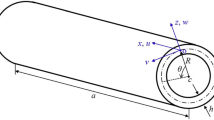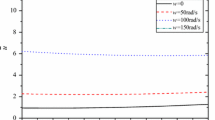Abstract
We analyze the initiation and propagation of adiabatic shear bands in a thick-walled 4340 steel tube with a V-notch in the middle. The material is modeled as strain hardening, strain-rate hardening and thermal softening. The deformations are assumed to be locally adiabatic and the effect of inertia forces is considered. Two different loadings, i.e., torsional, and combined torsional and axial pressure are considered. In each case, the load generally increases linearly from zero to the final value, is kept steady there for some time, then decreases to zero and is kept at zero; thus a finite amount of energy is input into the body. For the combined loading, the magnitude of the torsional loading pulse is kept fixed and the effect of varying the magnitude of the axial pressure preload is investigated. A shear band first initiates in the element adjoining the notch tip and propagates radially inwards. By recording the time when a shear band initiates at the centroids of different elements we determine its speed of propagation in the radial direction to vary from approximately 50 m/s at the instant of its initiation in an element abutting the notch tip, to nearly 90 m/s by the time it reaches the innermost surface of the tube; the speed also depends upon the overall loading rate, and whether or not the loading is multiaxial. The drop in the torque required to twist the tube at the initiation of a shear band is not as sharp as that in a thin-walled steel tube. We compute the distance through which a shear band propagates as a function of the energy input into the body and thus ascertain the energy required to drive a shear band through a unit distance.
We also study torsional deformations of a thick-walled CR-300 steel tube, model its thermal softening by a relation proposed by Zhou et al. and use material properties derived from their data. In this case, the speed of a shear band initiating from an element abutting the notch tip is found to vary between 750 m/s and 1,000 m/s at different points on a radial line through the notch tip; this agrees with that observed by Zhou et al. in their experiments on single-notched plates.
Similar content being viewed by others
Author information
Authors and Affiliations
Rights and permissions
About this article
Cite this article
Batra, R., Rattazzi, D. Adiabatic shear banding in a thick-walled steel tube. Computational Mechanics 20, 412–426 (1997). https://doi.org/10.1007/s004660050262
Issue Date:
DOI: https://doi.org/10.1007/s004660050262




